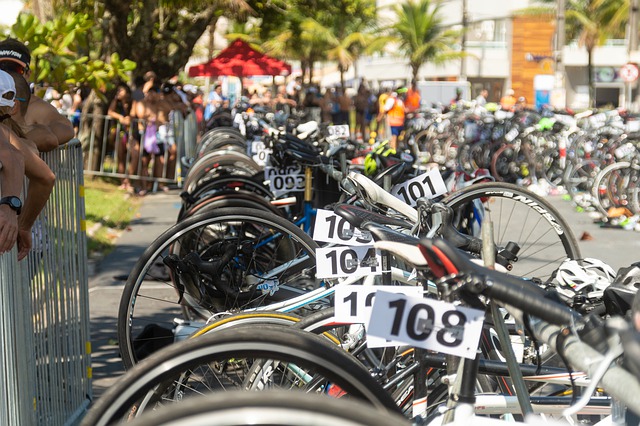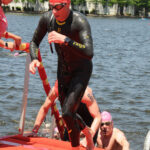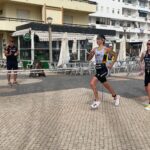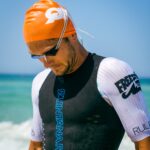In Part I of my two-part series exploring the powerful impact that routines can have on your triathlon efforts, I explained why routines are so important to every aspect of your training and racing. I also showed you how you can begin using routines in your conditioning workouts where the simpler environment enables you to focus more on your preparations and instill good routine habits.
In this article, I’ll illustrate how to develop routines for your discipline-specific training and, ultimately, to ensure that you are maximally ready to perform your best on race day from start to finish.
Training Routine
Once you’ve developed a conditioning routine that is well ingrained, you can then transfer those habits of preparation into a training routine that you use in your swimming, biking, and running workouts. For you to get the most out of your training efforts, you should develop a brief training routine that will ensure that you’re totally prepared for every drill, exercise, and workout in the three disciplines of triathlon. Your training routine is simply a discipline-specific version of your conditioning routine in which you get yourself prepared physically and mentally.
 Your training routine should only take a short amount of time—one-to-three minutes—but will completely prepare you to get the most out of your workout efforts. It will also lay the foundation for using a routine before and during races. Remember, for your training routine to become effective, you must use it consistently. Your training routine should consist of the following:
Your training routine should only take a short amount of time—one-to-three minutes—but will completely prepare you to get the most out of your workout efforts. It will also lay the foundation for using a routine before and during races. Remember, for your training routine to become effective, you must use it consistently. Your training routine should consist of the following:
- Identify goals for the workout.
- Review the specifics of the workout.
- Physical and technical warm-up before each exercise.
- Mental warm-up (e.g., self-talk, mental imagery, focus keywords, breathing).
Race Routine
The next step in developing effective triathlon routines is to create a race routine that is an extended version of your conditioning and training routines. The goal is the same, to be totally prepared to perform your best. The difference is that a race routine is usually much more detailed and thorough, may have a few more components, and usually takes longer to complete.
 There is no one ideal routine for everyone. Race routines are individual. For every great triathlete, you’ll see a different routine, but all will have common elements. You have to decide what exactly to put into your routine and how to structure it. Developing an effective race routine is a progressive process that will take time before you have one that really works for you.
There is no one ideal routine for everyone. Race routines are individual. For every great triathlete, you’ll see a different routine, but all will have common elements. You have to decide what exactly to put into your routine and how to structure it. Developing an effective race routine is a progressive process that will take time before you have one that really works for you.
Focus and intensity are two areas that you must consider most in developing your race routine. You should start by figuring out whether you have an internal or external focus style and what level of intensity at which you perform best. With that in mind, you want to plan your race routine so that when you begin a race, you are motivated, confident, focused and at an ideal intensity.
Focus style. An internal focus style means that you need to keep your focus narrow and on yourself to get prepared for a race. The goal in your race routine if you have an internal focus style is to put yourself in a place where there are few external distractions and where you can limit your focus to getting yourself ready to compete. To maintain that narrow focus, you want to go through your race routine away from other people that could distract you.
 An external focus style means that you need to keep your focus wide during your preparations so you can keep your mind off the upcoming race and away from thinking too much. The goal in your race routine, if you have an external focus style, is to put yourself in a place where your focus is drawn outward and you’re unable to become focused internally and think about the race. Your race routine should be done where there is enough activity to draw your focus away from inside your head. To widen your focus, you want to go through your race routine around teammates, other competitors, and activities that can draw your focus outward. This external focus will prevent you from overthinking, going negative, and getting nervous.
An external focus style means that you need to keep your focus wide during your preparations so you can keep your mind off the upcoming race and away from thinking too much. The goal in your race routine, if you have an external focus style, is to put yourself in a place where your focus is drawn outward and you’re unable to become focused internally and think about the race. Your race routine should be done where there is enough activity to draw your focus away from inside your head. To widen your focus, you want to go through your race routine around teammates, other competitors, and activities that can draw your focus outward. This external focus will prevent you from overthinking, going negative, and getting nervous.
Intensity needs. You’ll also want to build your race routine around your intensity needs. The intensity component of your race routine involves knowing how you want to feel physiologically, ranging from very relaxed to very fired up. It should include checking your intensity periodically as the race approaches and using psych-up or psych-down tools to adjust it as needed. You’ll need to set aside time in your routine when you can use these tools. As you approach the race, you’ll want to move closer to your ideal intensity. The short period just before the race should be devoted to a final check and adjustment of your intensity.
If you perform best at a lower level of intensity, you want your race routine to be done at an easy pace and have plenty of opportunities to take a break to slow down and relax. You’ll want to be around people who are relaxed and low-key as well. If you’re around anxious people, they’ll make you nervous too.
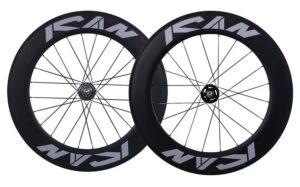 If you perform best at a higher level of intensity, you want your race routine to be done at a faster pace with more energy put into the components of your routine, particularly your physical warm-up. You will want to make sure that you are constantly moving. There should be little time during which you are just standing around and waiting. You’ll also want to be around people who are energetic and outgoing.
If you perform best at a higher level of intensity, you want your race routine to be done at a faster pace with more energy put into the components of your routine, particularly your physical warm-up. You will want to make sure that you are constantly moving. There should be little time during which you are just standing around and waiting. You’ll also want to be around people who are energetic and outgoing.
Designing a race routine. The first step in designing a race routine is to make a list of everything you need to do before a race to be prepared. Some of the common elements you should include are meals, review of race tactics, physical warm-up, technical warm-up, equipment check, nutrition, hydration, and mental preparation. Other more personal things that might go into a race routine include going to the bathroom, changing into your race clothing, and using mental imagery.
Then, decide in what order you want to do the components of your list as you approach the start of the race. I generally recommend that you create the following order when you arrive at the race site:
- Transition area set-up.
- Fueling.
- Physical warm-up.
- Review of race plan.
- Mental preparation (e.g., mental imagery, positive self-talk, breathing).
Next, specify where each step of your routine can best be completed. For instance, a place where you can do your physical warm-up, ride your bike, and go for a short swim before the race can influence when you accomplish different parts of your race routine.
 Finally, establish a time frame and a schedule for completing your routine. In other words, how much time do you need to get totally prepared? Some triathletes like to get to the race site only a short time before they compete. Others like to arrive hours before. All of these decisions are personal; you need to find out what works best for you.
Finally, establish a time frame and a schedule for completing your routine. In other words, how much time do you need to get totally prepared? Some triathletes like to get to the race site only a short time before they compete. Others like to arrive hours before. All of these decisions are personal; you need to find out what works best for you.
Once your race routine is organized, try it out at races. Some things may work and others may not. In time, you’ll be able to fine-tune your routine until you find the one that’s most comfortable and best prepares you to race. Lastly, remember that race routines only have value if they’re used consistently. If you use your routine before every race, in a short time, you won’t even have to think about doing it. Your race routine will simply be what you do and it will ensure that you are totally prepared to perform your best and achieve your triathlon goals.
Transition Routine
 Transitions are the most neglected part of triathlon racing, yet, the time you spend in T1 and T2 can either propel you into the next leg of a race or be a source of frustration and discouragement that can hurt your efforts as you move to the next leg of a race. I recommend that you put time into developing an effective transition routine and practicing it in both real life and in mental imagery.
Transitions are the most neglected part of triathlon racing, yet, the time you spend in T1 and T2 can either propel you into the next leg of a race or be a source of frustration and discouragement that can hurt your efforts as you move to the next leg of a race. I recommend that you put time into developing an effective transition routine and practicing it in both real life and in mental imagery.
I use what I call the “3 Rs” to summarize what you want to do physically and mentally in the two transitions:
- Rest: Allow your body to recover from the swim and relax before the bike.
- Regroup: Let go of any thoughts or emotions about the swim.
- Refocus: Shift your attention from the swim to the upcoming bike.
- Recharge: Increase intensity in preparation for the next leg of the race.
T1 routine. Here is a basic T1 routine that you can follow. I would encourage you, though, to tweak it in a way that is most comfortable and efficient for you (key advice: be methodical and don’t rush):
- Goggles up and sleeves off as you leave the water.
- Deep breaths and relax body as you run/walk from water to T1.
- Review your T1 routine.
- Arrive at your transition area (while continuing to breathe deeply through T1).
- Strip wetsuit.
- Bike shoes on (skip this step if your shoes are in your pedals already).
- Helmet and glasses on.
- Grab bike.
- Go!
T2 routine. T2 is usually simpler and easier than T1 because you’re not wet and don’t have to strip off your wetsuit (which can be difficult, frustrating, and energy sapping):
- Dismount.
- Relax your body and take deep breaths throughout T2.
- Focus on your transition routine.
- Rack bike.
- Remove bike shoes (if you didn’t before your dismount).
- Helmet off, hat on (if you wear a hat).
- Running shoes on.
- Number belt on.
- Grab gel.
- Go!
Every serious triathlete will tell you how they screwed up a transition and lost valuable time (not to mention getting flustered and distracted) because their transition routines weren’t deeply ingrained. I encourage you to write out your transition routines, and practice them in the weeks leading up to your races. And then rehearse your routines on the morning of a race with mental imagery.
When you establish structured routines in your training, races, and transitions, you will feel more confident, relaxed, and focused, all which will increase your chances of swimming, biking, and running fast from start to finish. And, regardless of the result, you’ll feel good about your effort because all you can do is be as prepared as you can be.
Do you want to take the next step in training your mind to perform your best in training and on race day? Here are five options for you:
- Read my Triathlon blog.
- Listen to my Train Your Mind for Athletic Success
- Read my latest mental training book: Train Your Mind for Athletic Success: Mental Preparation to Achieve Your Triathlons Goals.
- Take a look at myonline mental training courses.
- Schedule a 1:1 session with me.

